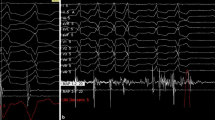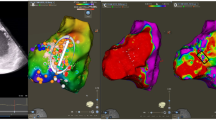Abstract
Prerequisite for succesful radiofrequency catheter ablation of tachycardias is the exact mapping during the electrophysiological study. The new mapping system CARTO allows a three-dimensional color-coded electroanatomic map of impulse propagation using electromagnetic technology. The aim of this study was to determine the feasibility and safety of the new electromagnetic mapping technology CARTO for atrial tachycardias.
Results: Electrophysiologic study and CARTO mapping was performed in 38 atrial tachycardias. The mapping procedure took 26 ± 23 min. We created 33 maps within the right atrium and 5 maps within the left atrium with a mean of 74 ± 38 different catheter positions. The mechanism was determined as reentrant in 9, junctional in 1 and focal in 28 tachycardias. In focal tachycardias the tachycardia cycle length (CL) and the total atrial activation time (AT) were clearly different (352 ± 98 ms vs 99 ± 25 ms). Reentrant tachycardias had a comparable CL and AT (236 ± 44 ms vs 240 ± 56 ms). In 83% of the focal tachycardias and in 67% of the reentrant tachycardias, ablation was performed successfully. No complications occured.
Conclusion: The electroanatomic mapping system allows high resolution visualization of electrical activity and may therefore improve precision and simplify the determination of the arrhythmogenic substrate during tachycardias for successful catheter ablation.
Similar content being viewed by others
References
Lesh MD, Van Hare GF, Epstein LM, Fitzpatrick AP, Scheman MM, Lee RJ, Kwasman MA, Grogin HR, Griffin JC. Radiofrequency catheter ablation of atrial arrhythmias. Circulation 1994;89:1074–1089.
Poty H, Saoudi N, Haissaguerre M, Abdou D, Clementy J, Letac B. Radiofrequency catheter ablation of atrial tachycardias. Am Heart J 1996;131(3):481–489.
Gepstein L, Hayam G, Ben-Haim SA. A novel method for nonfluoroscopic catheter-based electroanatomical mapping of the heart. In vitro and in vivo accuracy results. Circulation 1997;95/6:1611–1622.
Nimmermann P, Hoffmann E, Reithmann C, Remp T, Steinbeck G. Elektroanatomisches Mapping der sinuatrialen Aktivierung: Erste Erfahrungen mit dem neuen Mappingsystem CARTO. Z Kardiol 1998;87:227–232.
Hoffmann E, Reithmann C, Nimmermann P, Remp T, Ben-Haim S, Steinbeck G. Electroanatomic mapping of atrial activation during atrial tachycardia. PACE 1997;20(II):384.
Author information
Authors and Affiliations
Rights and permissions
About this article
Cite this article
Hoffmann, E., Nimmermann, P., Reithmann, C. et al. New Mapping Technology for Atrial Tachycardias. J Interv Card Electrophysiol 4 (Suppl 1), 117–120 (2000). https://doi.org/10.1023/A:1009894903100
Issue Date:
DOI: https://doi.org/10.1023/A:1009894903100




